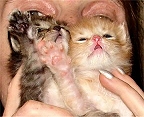Hydration is basically how much water we have in our system. Since water drives all of our metabolic functions, you can see why adequate hydration is essential.
The easiest way to check how hydrated your kitten is, is to grasp the skin firmly but gently between the kitten's shoulder blades, and lift it straight up with a twisting motion as you release it. Kitten skin that is well hydrated pops back within a second or less.

The longer it takes the skin to return to its place, the more fluids your kitten needs. In severely dehydrated kittens, the shelter manager may decide to inject water or electrolyte solution under the kitten's skin, for faster absorption.
Treatment: A kitten that is noticeably dehydrated should receive prompt veterinary attention. Treatment is directed at replacing fluids and preventing further losses.
In mild cases without vomiting, fluids can be given by mouth. If the kitten won't drink, give an electrolyte solution by bottle or syringe into the cheek pouch. When bottle feeding you can you plastic or glass bottles for the food.
Balanced electrolyte solutions for treating dehydration in children are available at drugstores. Ringer's lactate with 5 percent Dextrose in water and a solution called Pedialyte are suitable for kittens. They are given at the rate of two to four milliliters per pound body weight per hour, depending on the severity of the dehydration (or as directed by your veterinarian).
Feed the solution every 2 hours until the skin snaps back accordingly. Then start with a thin milk replacer mixed with the electrolyte solution.
|


